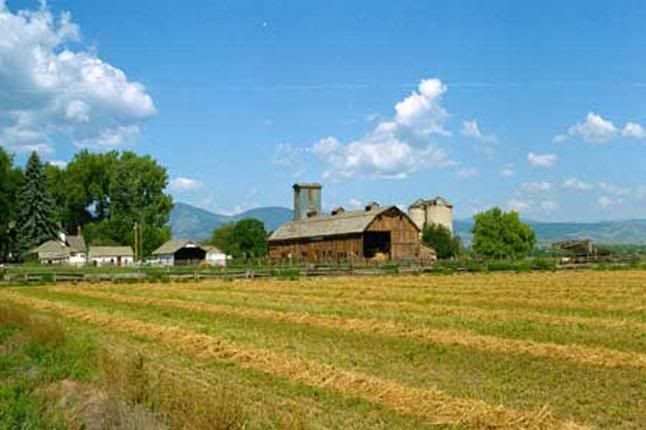
Historic Niwot Farm in Boulder County Colorado
Out of 94,000 acres of Boulder County Open Space land, about 24,000 acres are devoted to agriculture. The BCOS program values agriculture as an important resource to the community in preserving its heritage as a food producing region and for providing ongoing food security. This area has faced horrendous development challenges which continue to convert water availability to competing municipal uses. Just yesterday, the Denver Post featured an article updating the story of Colorado's agricultural water resources under constant siege: Colorado farmland goes dry as suburbs secure water supplies.
The purpose of this post is to report on a BCOS forum which was held a few days ago in which a panel of five farmers (two were organic) from the area answered a variety of questions about their farming methods, issues, ideologies, and marketing successes. Farm products being grown by this group include alfalfa, grass, cattle, corn, barley, organic vegetables, sugar beets, and wheat.
I'd like to focus on the "challenges" and "concerns" which this group expressed, since, while this county has some unique challenges, its challenges are representative in many ways with what farmers face elsewhere. This particular group of farmers is extremely in tune with today's food movements and sustainable farming methods.
To follow, were some random concerns expressed by members of the panel:
- Weather.
- Regulations (example was used about producing one's own product such as salsa). Also, land use.
- The amount of risk required.
- The high input costs and never knowing whether you'll recoup them.
- Risk of price volatility of commodities.
- The capital cost requirements for crops.
- Economics always comes first in planning and decision making.
- Trying to chase the market (planting more high value commodities).
- Selling food which has to compete with producers using unfair labor.
- Selling products which have to compete with unfair Ag subsidization policies.
- The challenge of transport by using busy highways for access to farms.
- Livestock fencing requirements near busy four-lane highways.
- Small parcels are inefficient, tractor wastes efficiency turning frequently.
- Difficulty finding employees or good workers. Youth spend all of their time on their cell phones. Almost every panelist mentioned this issue. One said he opted for larger equipment so he didn't need to hire help.
- Fortitude required. Stress.
- "Always have something in the ground." (so as not to miss good weather opportunities)
- Time required for equipment repairs, location of parts suppliers.
- Trying to find new "good" ground to add to farm operations.
- Manure as a fertilizer is becoming difficult to obtain as it goes to others first.
- Investing in irrigation, using many methods of irrigation, making irrigation decisions. This was the area where the most "reward" was attained via investment, some of which was funded in part through government programs such as NRCS. The NRCS and EQIP programs were cited as being extremely helpful for projects such as water, cover crops, hoop houses, low tunnels, and livestock waste water management.
- Getting the consumer to pick local production first. In Boulder County, $1B is spent on food each year, 3% of which is from local producers. Local production simply has to be consumer driven.
- That same consumer who "wants" to eat local doesn't tolerate farm smell, dust, or noise.
- It is difficult to farm on the urban interface.
- It takes time and work to market products. A couple of cooperatives were mentioned suggesting that the goal is to participate in an organized outlet, be it on a small or large scale. Large scale: A Denver outlet which sells to Whole Foods. Small scale: After some time, a group of five organic vegetable producers in Longmont have organized to work together to sell to the schools and restaurants.
- Fewer sales barns for selling livestock. "The Superior Internet Auction" works well.
- The length of time it takes for raising grass fed beef can be 3-3.5 years rather than 18 months fed in the feelot.
- Loss of regional grain elevators.
- GMO's need proper study and regulation.
- Improving the soil.... Overall, the group seemed to express that soil health is improving over these past 30 years due to improved practices of no-till, moldboard plowing, strip-tilling, adding manures, spending thousands of dollars on soil studies, doing crop rotation, and taking advantage of soil nutrition as a way of conserving water since it increases the water holding capacity.
- Getting "beat up" by the public. Having to defend every action with the public.
- "News flash. You ain't gonna get rich farming."
K. McDonald